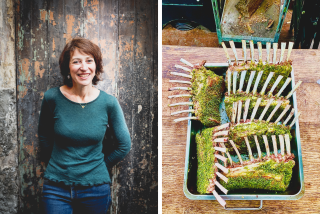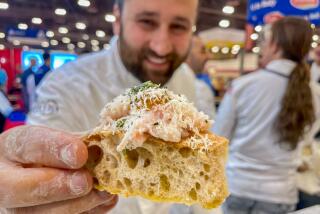The World-Class Street Snack of the Cote d’Azur : It’s <i> socca</i> --a crumbly bread served from Nice’s sidewalk stalls and gourmet kitchens.
NICE, France — There is no world cup of socca. Socca is not a dance from Trinidad (that’s soca ). Socca, which is pronounced “soak-ah,” is not mock-Italian for “get something wet.”
Socca is food--the quintessential street snack of Nice, capital of France’s Cote d’Azur. More specifically, it’s a kind of vast, thin pancake or crepe made from chickpea (garbanzo bean) flour mixed with water and a bit of olive oil and salt. The resulting batter is poured into huge copper (ideally) or cast-iron pans, a bit like paella pans but with straight sides, and baked quickly at high heat--preferably in a wood-burning oven. It is seasoned with more salt and fresh-ground black pepper--a condiment particularly favored in this part of France.
Visitors to Nice usually encounter socca for the first time at the city’s famous Marche aux Fleurs or Flower Market, on the southeastern end of the city, a block or so from the Mediterranean. This colorful, almost-daily (it’s closed Mondays), morning-long market stretches along the middle of the Cours Saleya, on the edge of Vieux Nice, old Nice--a warren of busy, hilly little cobblestone streets jam-packed with shops and restaurants, more Italian than French in character. (Nice, in fact, belonged to the Italians until 1860.)
Though one section of it is indeed devoted to flowers, the Marche aux Fleurs is primarily a fruit and vegetable market. Here, the bounty of the Nicoise countryside, and of neighboring corners of Provence and Italy, presents itself in opulent display. Whatever’s best and freshest in this part of Europe is on sale here: fat asparagus, long-stemmed purple artichokes, baby fava beans, jewel-like new potatoes in spring; cascades of cherries, apricots and peaches, Cavaillon melons, wild strawberries, sweet red and yellow peppers, eggplants in several colors and shapes in summer; earthy clumps of mushrooms, pyramids of pears, bundles of herbs in fall; gnarled sweet carrots, turnips, cabbages and lettuces in winter. But all year round, under a canopy in the middle of the market, stands an old Nicoise woman dispensing squares of bready lukewarm pissaladiere (the Nicoise pizza) and--more to the point--crumbling, crisp-bottomed wedges of socca.
Her socca pan is about four feet in diameter, and oily black. From it, with a spatula, she carves portions of the pancake, then deposits them in cones of waxed white paper--at 10 francs (about $1.50) per serving. In texture, socca is a bit like thin, unusually crumbly, unusually oily corn bread. In flavor, it also suggests corn bread, but also buckwheat crepes with a hint of hummus (also made from chickpeas) in the background. Socca seems very Mediterranean, and also somehow very ancient. You can imagine the Romans eating something like this as they traipsed around Southern Europe making history. You’ll love it or hate it. I find it irresistible.
According to Jean-Luc Bertin, proprietor of La Pastarella, a shop selling pasta, beans, various flours and other staples of the Nicoise diet in Vieux Nice, there are two recipes for socca: “the authentic Nicoise one and Jacques Medecin’s.”
Medecin, author of the definitive book on Nicoise cooking, is also the controversial ex-mayor of Nice. His father, Jean, held the post for some 35 years, and Jacques for 25. Jacques also became president of the regional council for the departement of the Alpes-Maritimes, the “state” in which Nice is located. But he was implicated in a number of scandals, including tax evasion, and was accused by political opponents of graft and embezzlement--and in 1990, while still in office, disappeared from Nice literally overnight and turned up in the Uruguayan resort town of Punta del Este, where he remains in self-imposed exile.
It certainly wasn’t his deviation from the traditional socca recipe that caused all the trouble. His version differs from the usual one only in proportions: He calls for mixing 250 grams of flour to a half-liter of water; the traditional formula says 300 grams to the same amount of water.
But you’ll get the real thing only in Nice. If socca in the Marche aux Fleurs only whets your appetite for the thing, you can find it in plenty of other places around town. To begin with, you can buy larger quantities of exactly the same socca at a little shop called Chez Therese on the rue Droite in Old Nice. It is they who supply the socca (and pissaladiere) sold at the market.
Nearby, on the rue Sainte-Reparte, is a charming, funky little hole-in-the-wall called Nissa Socca (Nissa is the local dialect name for Nice). The simple menu here includes pissaladiere, ratatouille, farcis (assorted vegetables stuffed with ground meat, bread crumbs, and herbs), salade nicoise, eggplant fritters, zucchini flan, assorted pizzas and, of course, superlative socca itself--all of it served with the utmost informality to patrons who perch on tiny stools at tiny tables.
In contrast, socca also finds its way onto the menu at one of Nice’s best restaurants, Don Camillo, a block or two from the Marche aux Fleurs. Here, young Nice-born chef Franck Cerutti offers contemporary interpretations of classic Nicoise dishes: baby squid sauteed with artichokes, olives and thyme; cod with roasted red peppers and white beans; stuffed rabbit with wild chicory salad and the like. And small red mullets, among the most flavorful of Mediterranean fish, served over a bed of paper-thin individual soccas with roasted eggplant salad on the side is a remarkable dish.
Arguably the best socca of all in Nice, however--and this is precisely the sort of thing the Nicoise love to argue about--is the one served as part of a deliciously eccentric, fixed-price Nicoise dinner at Barale. Here, it’s thicker than usual, wonderfully crisp on the top, slightly charred around the edges and positively creamy in the middle--a dream of socca.
Unfortunately, it almost gets lost in the crowd of accompanying dishes. Barale is a real “experience” restaurant--an old farmhouse, now completely surrounded by warehouses, near the city’s old port.
There is no menu: The food just starts coming--and, by the time you’re through, has given you a crash course in old-style Nicoise gastronomy. First there’s pissaladiere. Then socca, followed by salade nicoise (the real kind, with no lettuce, potatoes or green beans--just tomatoes, radishes, scallions, hard-cooked eggs, anchovies and tuna), cheese-and-herb-stuffed ravioli with a sauce of daube (the local version of boeuf bourguignon ), braised veal shoulder with mushrooms and sweet red peppers, a field green salad, a sweet Swiss chard tart with pine nuts, raisins and sugar-top crust and, finally, a bowl of fresh seasonal fruit.
Then comes coffee and a tiny glass of fiery marc (white brandy) , and along with it, communal choruses--led by Madame Barale to the accompaniment of a crosshatched old 78 r.p.m. record--of “Nissa la Bella,” an anthem singing the praises of the city. All this, mind you, costs no more than about $20 per person--wine included. If you ask me, the socca alone is worth that.
GUIDEBOOK: In Search of Socca
Barale, 39 rue Beaumont; telephone locally 93-89- 17-94.
Chez Therese, 28 rue Droite; no telephone.
Don Camillo, 5 rue des Ponchettes; 93-85-67-95.
La Pastarella, 29 rue Benoit Bunico; 93-85-76-53.
Nissa Socca, 7 rue Sainte-Reparte; 93-80- 18-35.
Two other simple restaurants in Nice serving good socca : Lou Pistou, 4 rue de la Terrasse; 93-62-21-82. Rene Socca, 2 rue Miralhetti; 93-62-37-81.
More to Read
Eat your way across L.A.
Get our weekly Tasting Notes newsletter for reviews, news and more.
You may occasionally receive promotional content from the Los Angeles Times.








